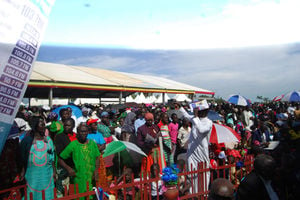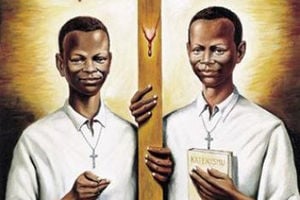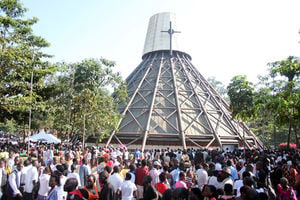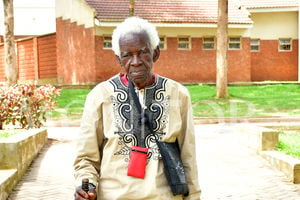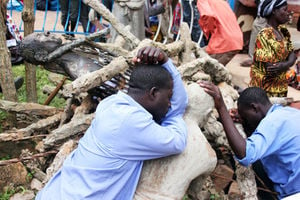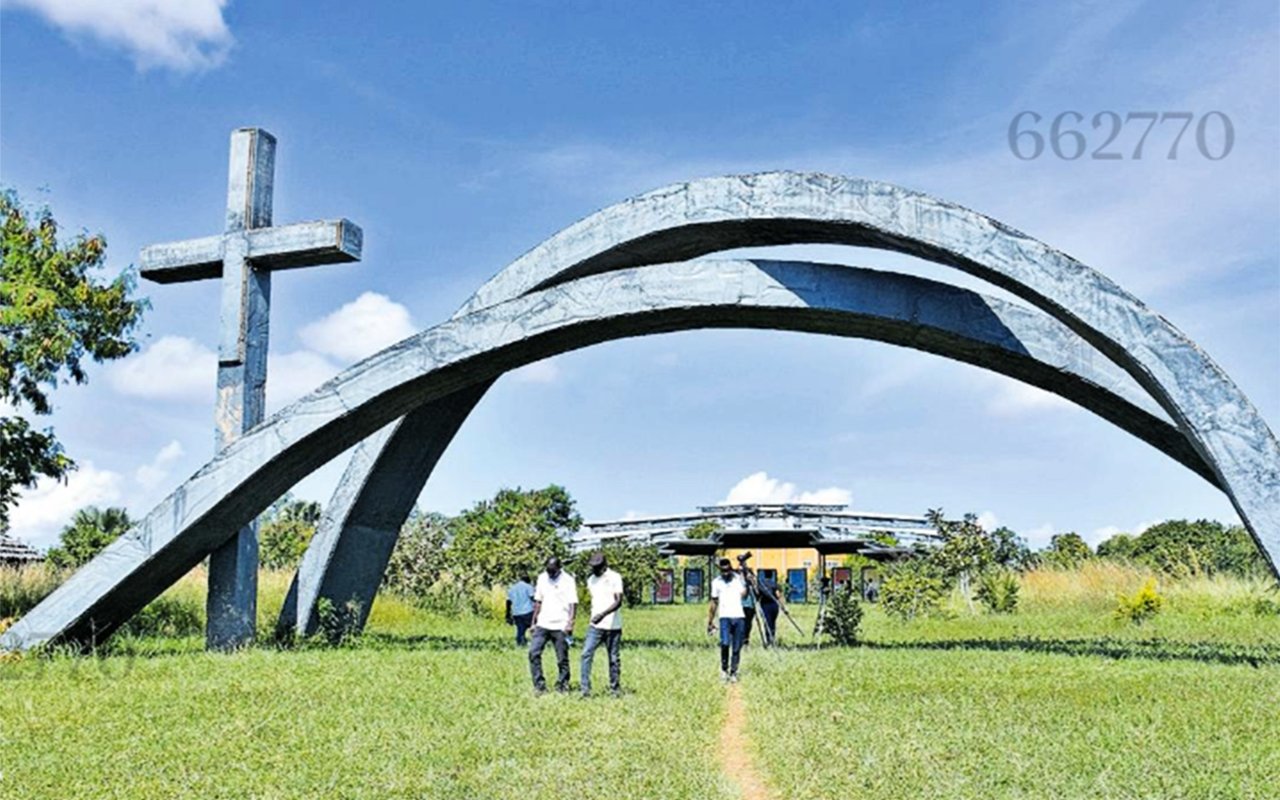
Two "hugging arches" at the entrance of WiPolo Martyrs Shrine in Agago District. Photo/Caesar Abangirah
The journey to WiPolo Martyrs Shrine in Paimol Sub- County, Agago District, takes about three hours on a winding and bumpy murram road from the neighbouring Gulu District to the east. But it is worth it when you finally reach your destination.
Two ‘hugging’ arches welcome you to the shrine, dedicated to martyrs Daudi Okelo and Jildo Irwa.
Designed by Architect Giuseppe Nicora, the longer arch on top represents Okelo, the older of the martyrs killed on October 18, 1918.
He was 17 when he was stabbed for preaching and spreading Christianity in the area formerly known as Pajimola, in Kitgum District, present day Agago. The name has since been changed to WiPolo – Heaven, according to Seminarian James Ojok.
“During their preaching, they cited the Lord’s Prayer, ‘Wonwa ma itye wi polo,’ meaning ‘Our Father in heaven,’ Ojok narrates.
The shorter arch at the bottom belongs to Irwa, believed to have been 14, when he too, was killed a few days later for refusing to renounce Catholicism.
The two arches also symbolise ‘protection’ and ‘support’- the protection offered by Okelo to his younger companion, and support Irwa gave Okelo as he was being stabbed.
To their left is a cross ‘they carried’ just like Jesus Christ, Ojok says, in their quest to spread religion. The cross faces the direction of the rising sun.
“After being killed, their bodies were left exposed to wild animals and none touched them,” Ojok says.
Next to the arches are panels with detailed history of the shrine, documenting the journey of the two catechists from Kitgum Diocese to Paimol after being baptised by Father Cesare Gambaretto, then the superior at the mission in Kitgum in June 1916.
A year later, they requested to replace Catechist Antonio who had died mysteriously the same year.

The mausoleum housing the tomb of Okello and Irwa. The religious site, WiPolo Martyrs Shrine in Agago District, is almost forgotten compared to Namugongo shrines in Wakiso District. Photo/Caesar Abangirah
At the spot where they were dragged out of their hut and killed is a mausoleum that contains a tomb for the two young martyrs, beatified at St Peter’s square Rome by Pope John Paul II in October 2002 following the significant historical evidence that supported their martyrdom.
At the foot of the tomb which slants westwards, are hundreds of rosaries, written petitions and prayer requests left behind by believers, for miracles. Next to it is a hole, dug by pilgrims in need of ‘holy soil’.
“It is believed that the soil from this pit cures several ailments and brings about good luck. Every day, we get people picking some soil that they take home. The testimonies are overwhelming,” Ojok says.
The pit grows bigger towards October, forcing caretakers to turn away some believers.
Besides soil from the pit next to the tomb, holy water is also in high demand from the pilgrims who turn up with jerrycans. Significantly, the shrine, constructed in 2015, is a spiritual destination that hosts close to one million pilgrims from different countries across the world every October 20. Kotido Diocese will animate this celebration due next month.
An altar, also designed by Nicora, overlooks the serene savannah grassland – most left untouched - and numerous rocks that dot the countryside. This is the new venue for Mass every Sunday after the smaller 500-capacity church ‘became small’, according to Ojok.
A century old tree, omweso ‘board’ and millet grinding areas carved in stone are some of the other significant features and tourist attractions at the shrine.
It is believed Okelo and Irwa held their prayers under the tree, and later relaxed and played the traditional mweso game in the rock under it. The millet grinding area was open to locals.
Lost gem
Although of religious significance, the site is almost forgotten compared to the more illustrious Namugongo Martyrs Shrine in Wakiso District which attracts millions of visitors annually.
“The biggest challenge we face is finances,” Brother Ojok tells a team of media practitioners during a tour organised by Uganda Tourism Board, “Little money comes through from the Archdiocese (Gulu). To make matters worse, we only realise at most Shs30,000 as offertory on Sunday despite the big number of people who attend mass. One would be lucky to find a Shs5,000 note in the offertory basket. If you do, then that person is not from within (the parish). If you find a Shs10,000 note, definitely that person is a visitor from outside the district,” he says. And yet the money is needed to keep the vast grounds - said to measure more than 20 acres - in pristine condition, pay bills among others.
“As you can see, most of the land surrounding the church is bushy. We need to pay people to have the grounds maintained but we cannot afford to. This site can as well become the second biggest religious destination in East Africa after Namugongo if we come together and put our minds to it.”
In 2021, President Museveni donated Shs100 million meant for the beautification of the shrine ahead of that year’s Martyrs Day celebrations. But more financial support is needed.
Recently, State Minister for Tourism, Martin Mugarra, blamed the financial limitations faced by the ministry for the terrible state of most of the tourist sites in the North.
“Of the 19 key tourism sites in the North, we are only in charge of nine and the reasons are mainly because of resources,” Mr Mugarra admitted.
Security concern
According to Ojok, Okelo and Irwa’s relics should be kept at the shrine, but they are currently housed at Gulu Archdiocese since the shrine does not have guards or a fence.
“We want to have the relics here but we cannot because vandals may break into the mausoleum and steal them,” he says.
Toilets have been constructed but with the overwhelming numbers expected in October, these might not be enough, which often leads to sanitation and hygiene complications.
Way forward
Uganda Tourism Board head of communications, Simplicious Gessa, highlighted the shrine’s high sentimental value and strategic location, noting its proximity to key wildlife areas such as Kidepo Valley National Park and Pian Upe, adding that it will improve faith-based tourism in Uganda.
According to Gessa, having a faith-based tourism site within this circuit leverages pilgrimage potential, making it a strategic marketing initiative for the country’s tourism sector.
“The shrine is part of a broader plan to revitalise faith-based tourism in Uganda, a resource with significant untapped potential for the sector,” he said.
He added that the country has since invested heavily in renovating religious sites and creating trails to boast this steadily growing product.
Recently, Members of Parliament from Northern Uganda visited several key tourism sites in the north and urged the government to fast track their development. The MPs established the inadequacy of key tourism infrastructure to support, boost and sustain tourism at various sites.
According to West Moyo MP, Tom Alero, the region continues to miss significant development opportunities resulting from the limited attention the government pays to developing the tourism sites.
The Legislators also noted that some tourist sites visited did not have modern state of the art facilities and information necessary to stimulate visitor experience, a hiccup Mr Mugarra said would be addressed.
